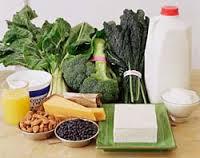Greeting hobgoblinswith a glass of milk or a handful of kale might sound more like a trick than a treat for Halloween.
But U.S. kids need calcium more than candy - according to the American Academy of Pediatrics (AAP), which has endorsed guidelines by the Institute of Medicine that call for a higher intake of calcium and vitamin D for young people. That endorsement came on the heels of research showing that on average, adolescent girls consume only 878 mg of calcium daily, which is 67% of their RDA. In fact, less than 15% of adolescent girls hit RDA targets for daily calcium.
Why does calcium intake matter so much?
Quite simply: almost 80 percent of lifetime bone mass is developed before age 18 for both females and males.
To develop a healthy skeleton for a lifetime -- one that will not easily fracture or succumb to osteoporosis -- young people must get the nutrients they need for building strong bones. Those nutrients include, not only calcium but also vitamin D, protein, magnesium and healthy fats. Vitamin D, helps the body to absorb calcium and magnesium. Magnesium supports healthy bone tissue, and balances calcium intake in a way that prevents constipation. A 2:1 ratio of calcium to magnesium is a good starting place for balancing the two.
And don't forget, weight-bearing and strength-building exercises like walking, running and weight training are important too. These types of exercises strengthen bones as well as muscles. Non-weight-bearing exercises such as swimming and bicycle riding, while good for the cardiovascular system and muscle strength, do little to build or strengthen bone.
The five most important things parents and kids can do to ensure they are building healthy bones for life, are:
- Eat 3 healthy servings of calcium rich foods each day such as yogurt, cheese, sardines, leafy greens, broccoli and nettles tea - (see chart below for the calcium RDA for different age groups).
- Be sure to get enough vitamin D (see "How Much Vitamin D do we need" below), preferably D.
- Eat plenty of magnesium rich foods such as green leafy vegetables, seeds (pumpkin seeds are very high) and avocados.
- Get at least 45 minutes of weight-bearing exercise each day and a minimum of three days each week.
- Take breaks from long periods of sitting. 10 minutes of running in place or jumping jacks helps bones and re-energizes, too.
Not only will children be healthier and more energized in the short-term, but the impact on their long-term health will be tremendous.
Keep in mind that bone is very complex and requires a wide range of nutrients beyond what is mentioned in this article. Eating a diet that is nutrient dense and based on whole foods will go along way to promote healthy and strong bones.
How much vitamin D do we need?
There is a lot of controversy about this nutrient. Vitamin D converts to an active hormone in the body. The two charts below show recommendations from the National Institutes of health. There are Adequate Intake and Upper Intake safety levels. The AI level recommendation is set very low and may not be adequate according to more recent studies. Getting enough vitamin D depends on many factors including how much sun you or your child gets. Typically I recommend a minimum of 1,000 IU for children and I test blood levels before supplementing higher doses.
The charts below are taken from the National Institute of Health Dietary Guidelines. The amounts listed means from all sources, diet and supplementation. It is always best get our nutrients from food when it is possible. Vitamin D is an exception for most since food sources do not contain enough of this nutrient. The sun can supply a significant amount. To learn more about sun production and vitamin D you can visit the following link - http://www.lanisimpson.com/video/how-the-sun-and-your-skin-make-vitamin-d/
SOURCES:
-Optimizing Bone Health in Children and Adolescents Pediatrics - Official Journal of the American Academy of Pediatrics
-Guidelines: Diet is the best source of calcium for children By Jenni Laidman
Current vitamin D Recommendations for Children May be Inadequate
Rajakumar K, et al. J Clin Endocrinol Metab. 2015;doi:10.1210/jc.2015-1643. June 23, 2015
